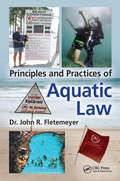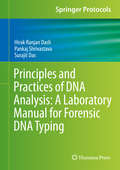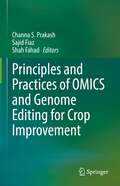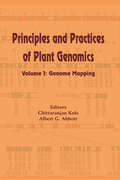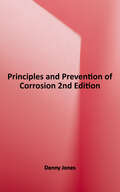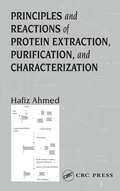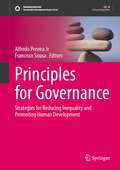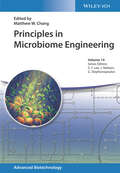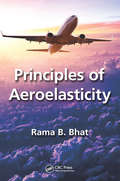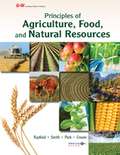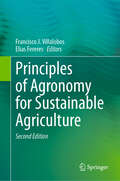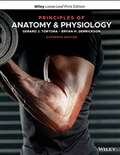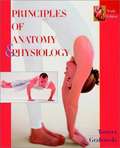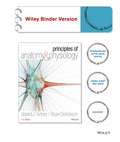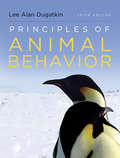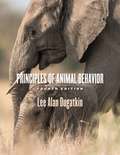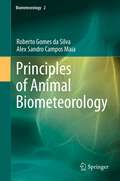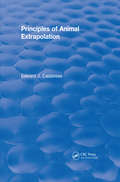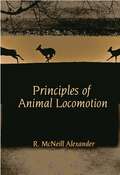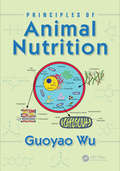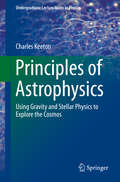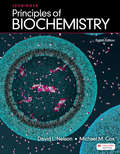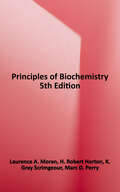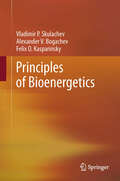- Table View
- List View
Principles and Practices of Aquatic Law
by John Robert FletemeyerPrinciples and Practices of Aquatic Law presents the best practices and principles related to aquatic law and risk management. Its focus is injury and death occurring in aquatic environments including the ocean, pools, water parks, canals, rivers, lakes, dams, etc. It discusses the importance of aquatic risk management as it relates to aquatic accident prevention and the concept of duty and liability for a facility’s management and staff. It also presents updated and relevant information about beach safety and the importance of hazard identification, warning, and elimination, and provides information for attorneys relating to the process of developing liability theories involving serious aquatic accidents and death. Features Presents a comprehensive resource on the applied practices and principles of aquatic law. Provides information for attorneys for the process of developing liability theories involving serious aquatic accidents and death. Presents updated and relevant information about beach safety and the importance of hazard identification, warning, and elimination. Discusses water-borne contaminants such as cryptosporidium and flesh-eating bacteria. Presents comprehensive public safety and beach management strategies: rip current prediction and monitoring, coastal engineering, drowning and rescue statistics, etc.
Principles and Practices of DNA Analysis: A Laboratory Manual for Forensic DNA Typing (Springer Protocols Handbooks)
by Surajit Das Hirak Ranjan Dash Pankaj ShrivastavaThe book presents hands-on protocols for conventional and advanced forensic DNA fingerprinting experiments. It includes manual, semi-automatic, and advanced automatic techniques for DNA extraction from different biological samples.It also discusses various qualitative and quantitative approaches for the assessment of extracted forensic DNA. It contains protocols for the amplification of short tandem repeat markers (STRs) for the amplification-based target enrichment of the forensic samples.Further, it examines genotyping of the STR loci through capillary electrophoresis and includes real-world case studies where forensic DNA analysis has been used in the criminal and civil disputes. The book concludes by presenting technological developments in the field of DNA forensic analysis. Suitable for beginners, it is a key reference resource on a wide variety of DNA profiling techniques and applications.
Principles and Practices of OMICS and Genome Editing for Crop Improvement
by Shah Fahad Channa S. Prakash Sajid FiazGlobal food security is increasingly challenging in light of population increase, the impact of climate change on crop production, and limited land available for agricultural expansion. Plant breeding and other agricultural technologies have contributed considerably for food and nutritional security over the last few decades. Genetic engineering approaches are powerful tools that we have at our disposal to overcome substantial obstacles in the way of efficiency and productivity of current agricultural practices. Genome engineering via CRISPR/Cas9, Cpf1, base editing and prime editing, and OMICs through genomics, transcriptomics, proteomics, phenomics, an metabolomics have helped to discover underlying mechanisms controlling traits of economic importance. Principle and Practices of OMICs and Genome Editing for Crop Improvement provides recent research from eminent scholars from around the world, from various geographical regions, with established expertise on genome editing and OMICs technologies. This book offers a wide range of information on OMICs techniques and their applications to develop biotic, abiotic and climate resilient crops, metabolomics and next generation sequencing for sustainable crop production, integration bioinformatics, and multi-omics for precision plant breeding. Other topics include application of genome editing technologies for food and nutritional security, speed breeding, hybrid seed production, resource use efficiency, epigenetic modifications, transgene free breeding, database and bioinformatics for genome editing, and regulations adopted by various countries around globe for genome edited crops. Both OMICs and genome editing are vigorously utilized by researchers for crop improvement programs; however, there is limited literature available in a single source. This book provides a valuable resource not only for students at undergraduate and postgraduate level but also for researchers, stakeholders, policy makers, and practitioners interested in the potential of genome editing and OMICs for crop improvement programs.
Principles and Practices of Plant Genomics, Vol. 1: Genome Mapping (Nextgen Agriculture)
by Albert G. Abbott Chittaranjan KoleGenome of an organism is depicted by genetic linkage mapping and physical mapping. Genome mapping stated with genetic linkage mapping and contributed enormously in genome analysis and its improvement. Physical mapping emerged later and is the prelude to structural and functional genomics. Volume One of Principles and Practices of Plant Genomics introduces the historical background of genome mapping, and delineates modern methods in the field. This volume briefly introduces the historical background and overview on genome mapping. Chapters deliberating on different types of molecular markers, their detection, relative merits, shortcomings and applications; types of mapping populations, methods of their generation, applications; basic concepts and schematic depiction of construction of genetic linkage maps; concepts and strategies of mapping genes controlling qualitative and quantitative traits on framework genetic linkage maps; rationale, methodologies and implications of comparative mapping; principles, strategies, and outcome of map-based cloning; overviews on the recent advances on plant genomics and genome initiatives; and finally computer strategies and software.
Principles and Prevention of Corrosion, 2nd Edition
by Denny JonesFor a senior/graduate-level course in corrosion. Comprehensive in approach, this text explores the scientific principles and methods that underlie the cause, detection, measurement, and prevention of many metal corrosion problems in engineering practice. Most chapters progress from qualitative, descriptive sections (including methods of prevention and testing) to more quantitative sections (involving metallurgy and electrochemistry) and, finally, to sections on current research developments in the chapter topic.
Principles and Reactions of Protein Extraction, Purification, and Characterization
by Hafiz Ahmed Hafiz Ahmed PhDPrinciples and Reactions of Protein Extraction, Purification, and Characterization provides the mechanisms and experimental procedures for classic to cutting-edge techniques used in protein extraction, purification, and characterization. The author presents the principles and reactions behind each procedure and uses tables to compare the different
Principles and Techniques of Biochemistry and Molecular Biology
by Keith Wilson John WalkerThis best-selling undergraduate textbook provides an introduction to key experimental techniques from across the biosciences. It uniquely integrates the theories and practices that drive the fields of biology and medicine, comprehensively covering both the methods students will encounter in lab classes and those that underpin recent advances and discoveries. Its problem-solving approach continues with worked examples that set a challenge and then show students how the challenge is met. New to this edition are case studies, for example, that illustrate the relevance of the principles and techniques to the diagnosis and treatment of individual patients. Coverage is expanded to include a section on stem cells, chapters on immunochemical techniques and spectroscopy techniques, and additional chapters on drug discovery and development, and clinical biochemistry. Experimental design and the statistical analysis of data are emphasised throughout to ensure students are equipped to successfully plan their own experiments and examine the results obtained.
Principles for Governance: Strategies for Reducing Inequality and Promoting Human Development (Sustainable Development Goals Series)
by Alfredo Pereira Francisco SousaThis edited volume provides strategies for reducing inequality and promoting human development through the use of innovative digital technology and the adoption of new bioethical principles for governance. The book is structured around a series of practical proposals which can be adapted to different circumstances, countries, and political systems. Written by an interdisciplinary panel of international researchers and professionals, each chapter details a proposal for a policy—new social technology, Green Deals, robust social assistance—that will move society forward towards a sustainable, digital, and equitable future. Researchers across multiple disciplines--public administration, cognitive technology, E-learning, finance, philosophy of economy, agronomics, forest engineering, bioethics and education—will find this volume a useful reference.
Principles in Microbiome Engineering (Advanced Biotechnology)
by Jens Nielsen Gregory Stephanopoulos Sang Yup LeePrinciples in Microbiome Engineering Provides an overview of the techniques and applications insight into the complex composition and interactions of microbiomes Microbiomes, the communities of microorganisms that inhabit specific ecosystems or organisms, can be engineered to modify the structure of microbiota and reestablish ecological balance. In recent years, a better understanding of microbial composition and host-microbe interactions has led to the development of new applications for improving human health and increasing agricultural productivity and quality. Principles in Microbiome Engineering introduces readers to the tools and applications involved in manipulating the composition of a microbial community to improve the function of an eco-system. Covering a range of key topics, this up-to-date volume discusses current research in areas such as microbiome-based therapeutics for human diseases, crop plant breeding, animal husbandry, soil engineering, food and beverage applications, and more. Divided into three sections, the text first describes the critical roles of systems biology, synthetic biology, computer modelling, and machine learning in microbiome engineering. Next, the volume explores various state-of-the-art applications, including cancer immunotherapy and prevention of diseases associated with the human microbiome, followed by a concluding section offering perspectives on the future of microbiome engineering and potential applications. Introduces a variety of applications of microbiome engineering in the fields of medicine, agriculture, and food and beverage products Presents current research into the complex interactions and relationships between microbiomes and biotic and abiotic elements of their environments Examines the use of technologies such as Artificial Intelligence (AI), Machine Learning (ML), and Big Data analytics to advance understanding of microbiomes Discusses the engineering of microbiomes to address human health conditions such as neuro psychiatric disorders and autoimmune and inflammatory diseases Edited and authored by leading researchers in the rapidly evolving field, Principles in Microbiome Engineering is an essential resource for biotechnologists, biochemists, microbiologists, pharmacologists, and practitioners working in the biotechnology and pharmaceutical industries.
Principles of Aeroelasticity
by Rama B. BhatIntroductory Guide on the Design of Aerospace Structures Developed from a course taught at Concordia University for more than 20 years, Principles of Aeroelasticity utilizes the author’s extensive teaching experience to immerse undergraduate and first-year graduate students into this very specialized subject. Ideal for coursework or self-study, this detailed examination introduces the concepts of aeroelasticity, describes how aircraft lift structures behave when subjected to aerodynamic loads, and finds its application in aerospace, civil, and mechanical engineering. The book begins with a discussion on static behavior, and moves on to static instability and divergence, dynamic behavior leading up to flutter, and fluid structure interaction problems. It covers classical approaches based on low-order aerodynamic models and provides a rationale for adopting certain aeroelastic models. The author describes the formulation of discrete models as well as continuous structural models. He also provides approximate methods for solving divergence, flutter, response and stability of structures, and addresses non-aeroelastic problems in other areas that are similar to aeroelastic problems. Topics covered include: The fundamentals of vibration theory Vibration of single degree of freedom and two degrees of freedom systems Elasticity in the form of an idealized spring element Repetitive motion Flutter phenomenon Classical methods, Rayleigh-Ritz techniques, Galerkin’s technique, influential coefficient methods, and finite element methods Unsteady aerodynamics, and more
Principles of Agriculture, Food, and Natural Resources: Applied Agriscience
by John S. Rayfield Kasee L. Smith Travis D. ParkNIMAC-sourced textbook
Principles of Agronomy for Sustainable Agriculture
by Francisco J. Villalobos Elias FereresThis updated second edition textbook explains the different technologies of agronomy to achieve a more sustainable agriculture, for undergraduate and graduate students of agronomy. The first section gives an overview of the crop energy balance, which covers partitioning of net radiation, and their effect on the thermal environment of the canopy. Water balance, as one of the biggest concerns under a changing climate, will also be thoroughly discussed. For the second section, the authors prepare all relevant information on crop production in relation to crop phenology, radiation interception and resource availability. With that in mind, the different agricultural techniques are analyzed in the third section, with special emphasis on quantifying the inputs required for a given target yield under specific environmental conditions. For each technique, the chapters provide guidance on improving the ratio between productivity and resource use, while ensuring sustainability.
Principles of Anatomy and Physiology
by Gerard J. Tortora Bryan H. DerricksonFrom the very first edition, Principles of Anatomy and Physiology has been recognized for its pioneering homeostatic approach to learning structure and function of the human body. The 16th edition continues to set the discipline standard by combining exceptional content and outstanding visuals for a rich and comprehensive experience. Highly regarded authors, Jerry Tortora and Bryan Derrickson motivate and support learners at every level, from novice to expert, and equip them with the skills they need to succeed in this class and beyond.
Principles of Anatomy and Physiology (10th Edition)
by Gerard J. Tortora Sandra Reynolds GrabowskiAnatomy textbook. * "Clinical Application" sections demonstrate the clinical or professional significance of the discussion. * Coverage of scientific research and breakthroughs in understanding the human body keep the book on the cutting edge.
Principles of Anatomy and Physiology 14th Edition
by Bryan Derrickson Gerard J. TortoraThis 14th edition of the phenomenally successful Principles of Anatomy and Physiology continues to set the standard for the discipline. Written and superbly illustrated for two-term, introductory Anatomy and Physiology students, this text offers a rich and complete teaching and learning environment.
Principles of Animal Behavior
by Lee Alan DugatkinPrinciples of Animal Behavior has long been considered the most current and engaging introduction to animal behavior. The Third Edition is now also the most comprehensive and balanced in its approach to the theoretical framework behind how biologists study behavior.
Principles of Animal Behavior, 4th Edition
by Lee Alan DugatkinSince the last edition of this definitive textbook was published in 2013, much has happened in the field of animal behavior. In this fourth edition, Lee Alan Dugatkin draws on cutting-edge new work not only to update and expand on the studies presented, but also to reinforce the previous editions’ focus on ultimate and proximate causation, as well as the book’s unique emphasis on natural selection, learning, and cultural transmission. The result is a state-of-the-art textbook on animal behavior that explains underlying concepts in a way that is both scientifically rigorous and accessible to students. Each chapter in the book provides a sound theoretical and conceptual basis upon which the empirical studies rest. A completely new feature in this edition are the Cognitive Connection boxes in Chapters 2–17, designed to dig deep into the importance of the cognitive underpinnings to many types of behaviors. Each box focuses on a specific issue related to cognition and the particular topic covered in that chapter. As Principles of Animal Behavior makes clear, the tapestry of animal behavior is created from weaving all of these components into a beautiful whole. With Dugatkin’s exquisitely illustrated, comprehensive, and up-to-date fourth edition, we are able to admire that beauty anew.
Principles of Animal Biometeorology
by Roberto Gomes da Silva Alex Sandro Campos MaiaThe book begins by describing in detail the mechanisms of energy exchange - radiative, convective, conductive and evaporative - together with techniques for their determination. The discussion extends to the importance of CO2, ozone and methane, together with that of aerosol pollutants and the evolution of atmospheric CO2. Subsequent chapters apply the results of the biophysical methods to mammals, birds and aquatic animals. Discussion includes problems of shelter and shade for animals in tropical environments and techniques for the thermal evaluation for shelters and for several tree types. The details of heat exchange between animals and the environment are presented, in separate chapters covering Mammals and Birds and Aquatic Mammals. A chapter on Shade and Shelter describes the importance of shade for animals, factors of shade efficiency, the protections offered by shelter and methods of calculating the protection afforded by both shade and shelter. A Special Methods chapter offers a variety of techniques for evaluating cutaneous and respiratory evaporation, and practical methods for sampling of hairs and the evaluation of hair coat characteristics.
Principles of Animal Extrapolation: Principles Of Animal Extrapolation (1991) (CRC Press Revivals)
by Edward J. CalabresePrinciples of Animal Extrapolation addresses the conceptual basis for animal extrapolation and provides an abundance of documentation that illustrates how these principles may be applied in the selection of the more appropriate models and in the interpretation of toxicological studies. The book analyzes and documents each specific biological cause of interspecies differences in susceptibility to toxic agents, including differences in absorption, gut flora, tissue distribution, metabolism, mechanisms and efficiencies of repair, and excretion. The problem of the heterogenicity of the human population is addressed through several chapters that assess the availability and prospects of developing predictive animal models for normal humans, as well as selected potential high-risk groups. Other topics presented in this book include the biological basis of regulatory actions involving attempts to extrapolate from exceptionally high exposure levels to realistic values, especially carcinogens; an assessment of genotoxicity tests, their ability to predict carcinogenicity in whole animals, and the manner in which they should be used by regulatory agencies; birth defects; and predicting the risk of human teratogenesis. Principle of Animal Extrapolation is essential for environmental toxicologists. It also provides valuable information to biomedical scientists (especially those involved in drug development and testing) and regulatory personnel in agencies such as the EPA, the OSHA, the NIOSH, and the FDA.
Principles of Animal Locomotion
by R. McNeill AlexanderHow can geckoes walk on the ceiling and basilisk lizards run over water? What are the aerodynamic effects that enable small insects to fly? What are the relative merits of squids' jet-propelled swimming and fishes' tail-powered swimming? Why do horses change gait as they increase speed? What determines our own vertical leap? Recent technical advances have greatly increased researchers' ability to answer these questions with certainty and in detail. This text provides an up-to-date overview of how animals run, walk, jump, crawl, swim, soar, hover, and fly. Excluding only the tiny creatures that use cilia, it covers all animals that power their movements with muscle--from roundworms to whales, clams to elephants, and gnats to albatrosses. The introduction sets out the general rules governing all modes of animal locomotion and considers the performance criteria--such as speed, endurance, and economy--that have shaped their selection. It introduces energetics and optimality as basic principles. The text then tackles each of the major modes by which animals move on land, in water, and through air. It explains the mechanisms involved and the physical and biological forces shaping those mechanisms, paying particular attention to energy costs. Focusing on general principles but extensively discussing a wide variety of individual cases, this is a superb synthesis of current knowledge about animal locomotion. It will be enormously useful to advanced undergraduates, graduate students, and a range of professional biologists, physicists, and engineers.
Principles of Animal Nutrition
by Guoyao WuAnimals are biological transformers of dietary matter and energy to produce high-quality foods and wools for human consumption and use. Mammals, birds, fish, and shrimp require nutrients to survive, grow, develop, and reproduce. As an interesting, dynamic, and challenging discipline in biological sciences, animal nutrition spans an immense range from chemistry, biochemistry, anatomy and physiology to reproduction, immunology, pathology, and cell biology. Thus, nutrition is a foundational subject in livestock, poultry and fish production, as well as the rearing and health of companion animals. This book entitled Principles of Animal Nutrition consists of 13 chapters. Recent advances in biochemistry, physiology and anatomy provide the foundation to understand how nutrients are utilized by ruminants and non-ruminants. The text begins with an overview of the physiological and biochemical bases of animal nutrition, followed by a detailed description of chemical properties of carbohydrates, lipids, protein, and amino acids. It advances to the coverage of the digestion, absorption, transport, and metabolism of macronutrients, energy, vitamins, and minerals in animals. To integrate the basic knowledge of nutrition with practical animal feeding, the book continues with discussion on nutritional requirements of animals for maintenance and production, as well as the regulation of food intake by animals. Finally, the book closes with feed additives, including those used to enhance animal growth and survival, improve feed efficiency for protein production, and replace feed antibiotics. While the classical and modern concepts of animal nutrition are emphasized throughout the book, every effort has been made to include the most recent progress in this ever-expanding field, so that readers in various biological disciplines can integrate biochemistry and physiology with nutrition, health, and disease in mammals, birds, and other animal species (e.g., fish and shrimp). All chapters clearly provide the essential literature related to the principles of animal nutrition, which should be useful for academic researchers, practitioners, beginners, and government policy makers. This book is an excellent reference for professionals and a comprehensive textbook for senior undergraduate and graduate students in animal science, biochemistry, biomedicine, biology, food science, nutrition, veterinary medicine, and related fields.
Principles of Astrophysics
by Charles KeetonProvides a physics-centered analysis of a broad range of astronomical systems that appeals to a large audience of advanced undergraduate students in physics and engineering This book gives a survey of astrophysics at the advanced undergraduate level It originates from a two-semester course sequence at Rutgers University that is meant to appeal not only to astrophysics students but also more broadly to physics and engineering students The organization is driven more by physics than by astronomy; in other words, topics are first developed in physics and then applied to astronomical systems that can be investigated, rather than the other way around. The first half of the book focuses on gravity Gravity is the dominant force in many astronomical systems, so a tremendous amount can be learned by studying gravity, motion and mass The theme in this part of the book, as well as throughout astrophysics, is using motion to investigate mass. The goal of Chapters 2-11 is to develop a progressively richer understanding of gravity as it applies to objects ranging from planets and moons to galaxies and the universe as a whole. The second half uses other aspects of physics to address one of the big questions. While "Why are we here?" lies beyond the realm of physics, a closely related question is within our reach: "How did we get here?" The goal of Chapters 12-20 is to understand the physics behind the remarkable story of how the Universe, Earth and life were formed. This book assumes familiarity with vector calculus and introductory physics (mechanics, electromagnetism, gas physics and atomic physics); however, all of the physics topics are reviewed as they come up (and vital aspects of vector calculus are reviewed in the Appendix).
Principles of Biochemistry
by David L. Nelson Michael M. CoxLehninger's Principles of Biochemistry earned acclaim for its presentation and organization of complex concepts and connections, anchored in the principles of biochemistry. This legacy continues in the eighth edition with a new framework that highlights the principles and supports student learning.
Principles of Biochemistry, 5th Edition
by Marc D. Perry Laurence A. Moran H. Robert Horton K. Gray ScrimgeourPrinciples of Biochemistry provides a concise introduction to fundamental concepts of biochemistry, striking the right balance of rigor and detail between the encyclopedic volumes and the cursory overview texts available today. Widely praised for accuracy, currency, and clarity of exposition, the Fifth Edition offers a new student-friendly design, an enhanced visual program, new Application Boxes, contemporary research integrated throughout, and updated end-of-chapter problems.
Principles of Bioenergetics
by Alexander V. Bogachev Felix O. Kasparinsky Vladimir P. SkulachevPrinciples of Bioenergetics summarizes one of the quickly growing branches of modern biochemistry. Bioenergetics concerns energy transductions occurring in living systems and this book pays special attention to molecular mechanisms of these processes. The main subject of the book is the "energy coupling membrane" which refers to inner membranes of intracellular organelles, for example, mitochondria and chloroplasts. Cellular cytoplasmic membranes where respiratory and photosynthetic energy transducers, as well as ion-transporting ATP-synthases (ATPases) are also part of this membrane. Significant attention is paid to the alternative function of mitochondria as generators of reactive oxygen species (ROS) that mediate programmed death of cells (apoptosis and necrosis) and organisms (phenoptosis). The latter process is considered as a key mechanism of aging which may be suppressed by mitochondria-targeted antioxidants.
